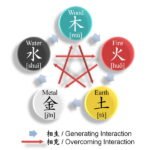Introduction to Korean Art
Korean art, a vital reflection of the nation’s rich heritage and cultural evolution, holds a unique place within the broader tapestry of East Asian art forms. Distinguished by its innovative spirit and aesthetic principles, Korean art dates back thousands of years, offering insights into the historical context and socio-political dynamics of the region. As both a mirror and a mold of society, it embodies the values, beliefs, and aspirations of the Korean people throughout different eras.
The significance of Korean art cannot be understated; it serves as a tool for understanding the nuances of Korean identity and the resilience of its cultural expressions. Unlike other East Asian art traditions, which often draw heavily on imported influences, Korean art demonstrates a remarkable sense of originality and adaptation. This distinctive character is most evident in traditional practices such as ceramics, painting, and textiles, which exhibit a striking combination of functionality and beauty.
One of the most important characteristics of Korean art lies in its deep connection to nature and daily life. The philosophy of utilizing natural materials and embracing simplicity has shaped artistic endeavors, presenting themes of harmony, balance, and transience found throughout the landscape. Moreover, the unique emphasis on community and shared experiences distinguishes Korean art, as it often reflects collective values rather than solely individual expressions.
As we delve deeper into the evolution of Korean art, it becomes essential to explore the various historical periods that have influenced its trajectory. Each era, from the prehistoric cave paintings to the modern contemporary art scene, showcases the continuous dialogue between tradition and innovation, ultimately embodying the spirit of Korea. Through this exploration, we gain valuable insight into how Korean art has evolved while maintaining its core essence.
Prehistoric and Ancient Korean Art
The earliest manifestations of artistic expression in Korea can be traced back to prehistoric times, with foundational developments occurring during the Paleolithic and Neolithic periods. One of the most notable art forms from this era is the petroglyphs, which are rock engravings that provide insight into the lives and beliefs of early Koreans. These intricate images often depict hunting scenes, animals, and human figures, suggesting a deep connection to the natural world and the spiritual beliefs of the people.
As the Neolithic period advanced, the emergence of the Mumun pottery culture, which flourished from approximately 1500 to 300 BCE, marked a significant milestone in Korean art history. Characterized by its grayish and reddish pottery, the Mumun culture produced utilitarian vessels that were often decorated with cord-marked patterns. This distinctive pottery not only served practical purposes but also reflected the social structures and cultural practices of its time, demonstrating an early understanding of aesthetics and functionality. The presence of burial jars crafted during this period signifies the importance of rituals and the afterlife, suggesting that artistry transcended mere functionality.
Additionally, monumental structures like dolmens—massive stone tombs built for the elite—bear testament to the advanced engineering capabilities and communal efforts of prehistoric societies. These structures, often adorned with simple carvings or engravings, serve as a crucial link to understanding the spiritual and social hierarchies of early Korean civilizations. The dolmens, along with the remains of ritualistic pottery and grave goods, emphasize the importance of art in expressing identity, belief systems, and the transition between life and death.
Thus, prehistoric and ancient Korean art laid the groundwork for the rich tapestry of cultural expression seen in subsequent eras, showcasing the intricate relationship between utility, spirituality, and artistry that has persisted throughout Korean history.
The Three Kingdoms Period
The Three Kingdoms Period, which lasted from 57 BC to 668 AD, was a significant era in Korean history, marked by the rise of three prominent kingdoms: Goguryeo, Baekje, and Silla. This period saw profound artistic developments influenced largely by the region’s rich cultural and religious heritage. Each kingdom displayed distinctive styles in their art, particularly in relation to Buddhist iconography, which played a pivotal role in shaping and reflecting societal values and beliefs.
Goguryeo art is renowned for its dynamic tomb murals that often depicted themes related to everyday life, warfare, and religious practices. The murals, characterized by vibrant colors and intricate designs, not only served a decorative purpose but also were believed to protect the deceased in the afterlife. The emphasis on movement and energy within these artworks reflects the kingdom’s warrior society and its appreciation for a heroic narrative.
In contrast, Baekje art is recognized for its refined elegance and sophisticated techniques, particularly in sculpture and pottery. The royal tombs of Baekje housed exquisite stone sculptures and beautifully crafted earthenware, often illustrating Buddhist figures and symbols. This emphasis on spiritual representation signifies the kingdom’s commitment to Buddhism, showcasing how the religion influenced the aesthetics of the time. The artworks from Baekje exhibit a softer, more graceful style, distinguishing it from the more vigorous expressions found in Goguryeo.
Silla, the southernmost kingdom, developed its signature art style with a focus on goldsmithing and ceramics. The famous golden crowns from Silla, adorned with intricate designs and symbolic elements, highlight the kingdom’s advancements in metallurgy and its cultural connections with the broader East Asian context. Additionally, Silla’s tomb murals, while less prevalent than those found in Goguryeo, were nonetheless significant in representing Buddhist themes and local beliefs.
Overall, the art of the Three Kingdoms Period encapsulates the intertwined relationship between religion and culture, underscoring how these kingdoms expressed their identities and aspirations through artistic endeavors.
The Unified Silla and Goryeo Dynasties
The Unified Silla period, spanning from 668 to 935 AD, marked a pivotal era in the development of Korean art, characterized by significant advancements in craftsmanship and aesthetic expression. During this time, the influence of Buddhism became increasingly prominent, guiding artisans in their creative endeavors. One of the most notable artistic achievements of the Unified Silla era was the creation of elaborate gold crowns, which symbolized authority and divine right. These crowns, often adorned with intricate designs and precious stones, exemplified the skill of Silla metalworkers and their ability to combine function with spiritual significance.
Following the Unified Silla period, the Goryeo dynasty (918-1392 AD) emerged, further enriching the tradition of Korean art. This era is particularly renowned for its exquisite celadon pottery, a high-fired stoneware known for its distinctive jade green glaze. The Goryeo artisans perfected the technique, creating vessels that not only served practical purposes but also showcased the grace and elegance of Korean aesthetics. This pottery was often adorned with intricate inlays, depicting natural motifs and reflecting the deep connection between nature and the spiritual world that was prevalent at the time.
In addition to metalwork and pottery, the religious influence of Buddhism continued to manifest in the art of the Goryeo dynasty through the creation of stunning Buddhist paintings and sculptures. These artworks were not merely decorative; they served to convey spiritual teachings and reinforce the Buddhist worldview among the populace. The craftsmanship involved in creating these pieces illustrated the mastery of Goryeo artists, who blended traditional techniques with innovative approaches to spirituality and art.
Artistic advancements during the Unified Silla and Goryeo periods laid a solid foundation for future generations, establishing a rich cultural heritage that continues to influence Korean art today. The legacy of this era not only highlights the technical skill of artisans but also reflects the integral role of Buddhism in shaping Korea’s artistic landscape.
The Joseon Dynasty: A Golden Age of Korean Art
The Joseon Dynasty (1392-1910) is often regarded as a golden age of Korean art, marked by a unique blend of aesthetic innovation and cultural depth. This period was characterized by a proliferation of distinct art forms, which includes landscape painting, ceramics, and calligraphy, reflecting the philosophical underpinnings of Confucianism prevalent during the era. The dynamic interplay between personal expression and collective values resulted in artworks that were not only visually captivating but also rich in meaning.
Landscape painting rose to prominence within the artistic community during the Joseon Dynasty, distinguished by its meticulous attention to nature and harmonious composition. Artists began to explore their surroundings with a deep appreciation for the subtlety and beauty of the natural world. Notable figures, such as Kim Hong-do, excelled in this genre, creating works that captured the landscapes of Korea while also incorporating human elements. His paintings often depicted daily life and the interconnectedness of humans with nature, resonating with the values of harmony and balance emphasized in Confucian thought.
Calligraphy, another esteemed art form in the Joseon period, served as both a practical skill and a highly regarded artistic discipline. Scholars and artists meticulously cultivated their brushstroke techniques, leading to the emergence of distinct styles that captured personal expression and scholarly ambition. This focus on calligraphy paralleled the era’s respect for education and intellectualism, demonstrating that art was intertwined with the socio-political fabric of Korean society.
Furthermore, ceramics underwent significant advancements during the Joseon Dynasty, particularly with the development of blue-and-white porcelain, which became emblematic of Korean artistry. The refined aesthetic and craftsmanship of ceramics were celebrated not only for their beauty but also for their functionality, reflecting the practicality ingrained in Confucian society. This period indeed stands as a testament to the flourishing of artistic endeavors, leaving a lasting impact on Korean cultural heritage.
Modern and Contemporary Korean Art
The transition to modern and contemporary Korean art began in the late 19th century, marked by a pivotal shift influenced by Western artistic movements. This era witnessed the introduction of new techniques and styles, varying significantly from the traditional Korean art forms that had predominated. Artists started to merge Western styles with traditional aesthetics, producing hybrid works that reflected the complexities of identity and cultural exchange during this transformative period. The onset of Japanese colonial rule further altered the artistic landscape, creating a tension between indigenous expression and imposed cultural narratives.
The aftermath of the Korean War in the 1950s served as a catalyst for artists seeking to address the fragmented national identity. In this context, modern art became a medium through which personal and collective traumas were expressed. Notably, the revolutionary video artist Nam June Paik emerged, often considered the father of video art. Paik’s innovative use of technology challenged the traditional boundaries of art, paving the way for future generations to explore the intersection of art and media. His iconic works often reflected a blend of cultural critique and a deep connection to his Korean roots, establishing him as a seminal figure in the global art scene.
As globalization progressed, contemporary Korean art continued to evolve, producing various movements that resonate with both local and international audiences. Artists like Lee Bul and Kimsooja have utilized diverse mediums—ranging from installation art to performance—to comment on social issues, including identity, gender, and the rapid changes within society. The contemporary art scene in Korea has gained international prominence, with major exhibitions drawing attention to the innovative practices that address the socio-political landscape of the region. This ever-evolving dialogue within Korean art emphasizes the ongoing influence of history and the scope of artistic expression in an interconnected world.
Regional Variations in Korean Art
The landscape of Korean art is notably diverse, shaped significantly by the geographical and cultural attributes of various regions. Each locality, through its unique resources and traditions, has contributed distinct styles that reflect the individuality of its artists and communities. This regional differentiation plays an important role in understanding Korean art as a whole.
One of the most celebrated examples is the pottery style originating from Buan, located along the western coast of Korea. Buan pottery, characterized by its intricate glazes and unique shapes, showcases a mastery of local clay and techniques that have been passed down through generations. The area’s rich natural resources, including abundant clay deposits and suitable firing conditions, allowed artisans to innovate while remaining true to traditional methods. This artistic legacy has not only influenced local craftsmanship but has also gained recognition on a national and international level.
Similarly, the Gyeongju area, once the capital of the ancient Silla Kingdom, is famed for its remarkable sculptures, particularly during the Three Kingdoms Period. The sculptures from Gyeongju often depict Buddhist themes and reflect the deep spiritual connections of the region. The availability of local materials, such as granite, facilitated the creation of grand structures and intricate carvings that continue to inspire admiration today. The artistic richness of Gyeongju is emblematic of how regional resources can shape the artistic narrative, making it a focal point in the study of Korean art.
In conclusion, the regional variations in Korean art highlight the interplay between geography and artistic expression. From the pottery of Buan to the sculptures of Gyeongju, these distinctive styles underline the richness of Korea’s artistic heritage, emphasizing the importance of locality in the evolution of artistic practices across the country.
The Influence of Traditional Korean Art on Global Art
Traditional Korean art, deeply rooted in the country’s history and culture, has made significant contributions to the landscape of global art. This influence can be observed through various forms of artistic expression, including painting, ceramics, and sculpture. As artists traveled and exchanged ideas across borders, the unique aesthetics of Korean art began to resonate with and inspire their international counterparts.
The introduction of traditional Korean techniques, such as brushwork and natural dyeing, has captivated artists from different cultural backgrounds. For instance, the traditional practice of creating Korean celadon pottery has merged with modern ceramic techniques in collaborative projects between Korean artisans and global artists. This synergy allows for the blending of cultural heritage with contemporary design, thus broadening the appreciation for Korean artistry among a global audience.
Moreover, Korean art has gained recognition in international exhibitions, significantly enhancing its presence in global art markets. Events like the Venice Biennale have showcased the work of Korean artists, facilitating dialogues about heritage and modernity in their creations. These exhibitions have not only highlighted traditional Korean themes but have also demonstrated how artists interpret these elements in the context of current global concerns, such as identity and sustainability.
Collaborations between Korean artists and their international peers have fostered a rich exchange of artistic ideas. This cross-pollination encourages an exploration of intercultural narratives, allowing both parties to challenge their own artistic boundaries. As traditional Korean art continues to engage with new movements and technologies, it enriches the global art scene, proving that the heritage of one culture can find resonance across diverse artistic landscapes. The integration of these influences ultimately contributes to a more holistic understanding of art as a shared human experience.
Conclusion: The Legacy of Korean Art
Korean art holds a distinctive place in the global artistic landscape, characterized by its deep historical roots and continuous evolution. Throughout the centuries, it has undergone significant transformations, informed by historical events, cultural shifts, and interactions with neighboring nations. From the ancient pottery of the Neolithic period to the intricate brushwork of traditional painting, each era has contributed to a rich tapestry that illustrates Korea’s unique cultural identity.
The legacy of Korean art is not solely reflected in its historical significance; it also serves as a contemporary medium of expression. As globalization continues to influence artistic practices worldwide, Korean artists are at the forefront of blending traditional techniques with modern themes. This fusion not only preserves the essence of past artistic practices but also reinvents them to resonate with today’s audiences. Through contemporary works, Korean artists engage in global dialogues, redefining cultural exchange and fostering an understanding of Korea’s heritage.
Looking to the future, Korean art is poised for further transformation as it navigates the complexities of a global society. The rise of digital art forms and new technologies presents unprecedented opportunities for Korean artists to innovate and reach broader audiences. Moreover, the preservation practices surrounding historical works ensure that the narrative of Korean art continues to inform future generations.
In light of its historical depth and modern dynamism, Korean art transcends the notion of mere cultural artifacts. It serves as a vital mode of communication, articulating the nuances of Korean identity and heritage to the world. As we reflect on the ongoing journey of this remarkable artistic tradition, it is clear that the legacy of Korean art will remain significant for generations to come.















